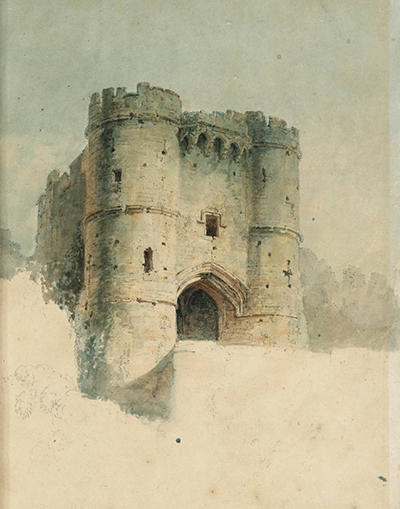 Buy Art Prints Now
Buy Art Prints Nowfrom Amazon
* As an Amazon Associate, and partner with Google Adsense and Ezoic, I earn from qualifying purchases.
There are hundreds of sketchbooks that remain from the career of JMW Turner, with pencil, chalk and ink being the three tools that William Turner used to fill them with breathtaking drawings, simple watercolours, preparatory sketches and study pieces.
Fundamental to most artists have been their skills as a draughtsman. Turner would take sketchbooks with him where ever he went, so that any opportunity to practice and hone his skills could be taken. Original sketches attributed to Turner now can be listed in their thousands and most that still remain have been collected together for the Turner Collection at the Tate. Such sketching allows us to look directly into the mind of the artist and understand more about the methods use to plan and disect the scene that he was producing. (The photograph on the left is from the artwork titled Carisbrooke Castle, Isle of Wight: The Gateway and this can be found in Turner's Isle of Wight Sketchbook.)
The sketchbooks that we have found stretch across his whole life, thus enabling us to understand in great detail the developments that he made as his life progressed. William Turner would use India ink and tobacco-water to adapt his sketch books when using them outdoors. This subtle colouring reduced glare from impeding his work. He also made other customisations to some of his books in order to create drawings and watercolours exactly as he wanted. Sometimes the artist would customise items himself, other times he might order them to be adapted especially for him.
William Turner is considered to be one of the finest British artists of all time but this significance was not matched by the way in which his drawings were stored during his own lifetime. It was only after his death that all of his sketchbooks were discovered, purely by accident. Years of research since has allowed us to understand more about how they fitted into his overall career. The majority of his drawings were found boxed-up in his studio, some tidied away on endless shelves which did not reflect the beauty and brilliance of what would be found in these many sketchbooks.
There were around three hundred sketchbooks in total and the majority of artworks found within them were produced using pencil. This format suited the artist's tendency to travel and he would tend to hold them within his coat pockets. They were never intended for public consumption, but such was his success that anything from his hand would be in high demand. The sketchbooks themselves cover such a large part of his career that there is plenty of variation in style, providing a visual display of his own artistic development. Aside from the many pencil sketches there were also plenty of paintings with an experimental use of watercolours, with this medium being a particularly hard skill to master.
Turner felt the need to keep most of these drawings and preparatory watercolours private. He believed it was preferable to keep his artistic techniques shrouded in mystery and it was only after his death that all this side of his career was uncovered. The artist's significance within British art has ensured that each and every artwork from his lifetime has been dragged from obscurity, documented in detail and exhibited. Indeed, in recent years there have been extensive publications and entire exhibitions devoted purely to the work of Turner within the medium of drawing.
This section covers all the major sketchbooks from his career, most of which are now owned by the Tate in the UK. This intriguing collection of work documents his entire career, from teenage experimenting to his groundbreaking journeys across Europe, taking in Venice, Switzerland and France. There is also a considerable variety in the sizes of these sketches, with some books chosen for portability and others with the intention of producing presentable artworks in their own right.




